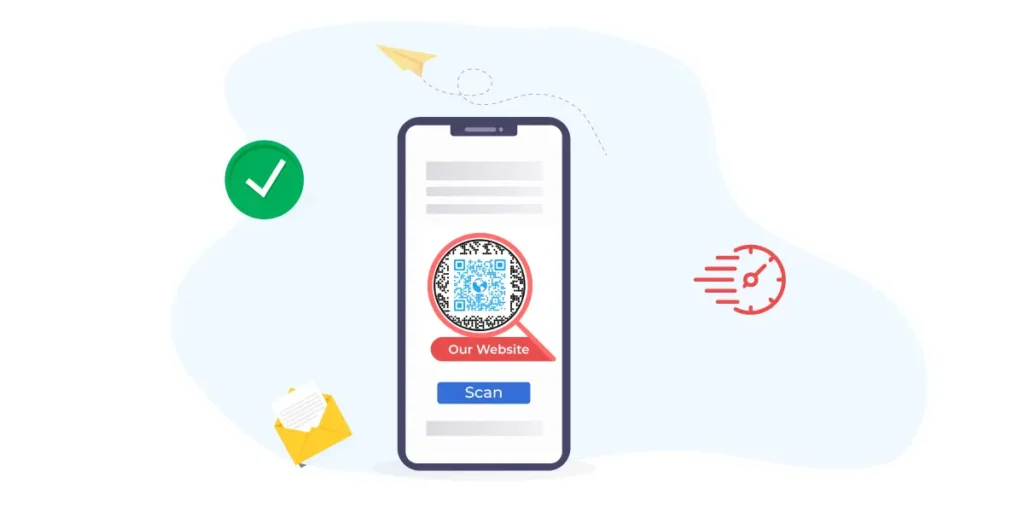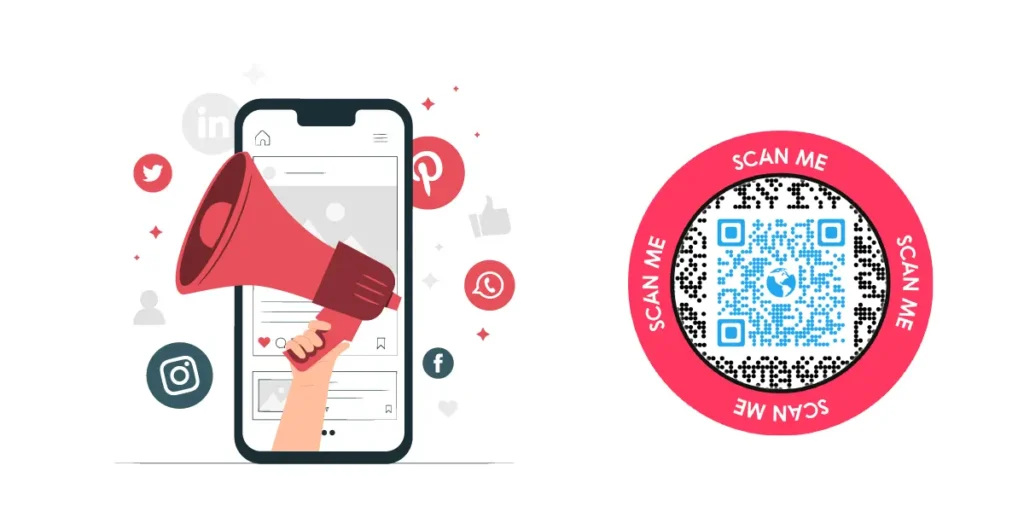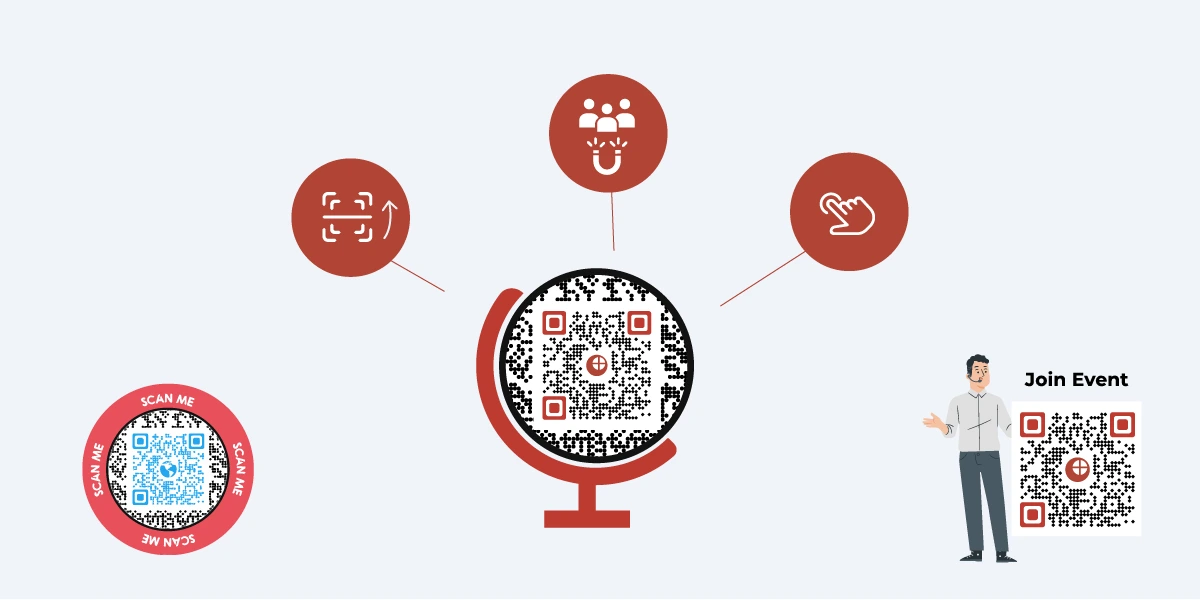QR Code frame is an interesting feature that helps make your QR Code attractive. And you would’ve seen one already.
A frame is placed around your QR Code to make it blend well with your creative designs and grab the audience’s attention.
In addition, it also often has a CTA (call to action) that lets your audience know what the QR Code does.
It is a known fact that QR Code with a frame attracts 50% more scans than generic ones.
In this guide, you’ll learn everything about making a QR Code with a frame, its benefits, best practices, and more.
Let’s start with making a QR Code frame using Scanova’s QR Code Generator.
A. What is a QR Code frame
A QR Code frame typically refers to a QR design that includes a decorative or branded border around the edges of the QR itself.
The frame is an additional visual element that surrounds the traditional patterns of a QR.
This framing can serve several purposes:
- Aesthetic appeal: Adding a frame can make the QR visually appealing, especially if it aligns with a particular theme, brand, or design.
- Branding: Companies or individuals may include their logo or brand elements in the frame to reinforce their brand identity.
- Identification: The frame might help draw attention to the QR, making it more noticeable in print or digital media.
Customization: Frames provide an opportunity to customize the appearance of the QR to suit the overall design of a product, advertisement, or any other material.
Learn all about how to design a QR Code
B. How to create a QR Code frame

1. Begin by accessing the Scanova QR Code Generator on the internet
2. Choose any relevant content category of your choice. For a demo, we’ll choose the “Website URL” option from the menu and input the desired URL. This will be the web address your QR Code directs to when scanned
3. Make a selection between a “static” or “dynamic” QR Code. The default choice here is the dynamic option
4. Initiate the QR Code generation process by clicking the “Generate QR Code” button. This action will produce a basic black-and-white QR Code linked to your website
5. Now, you’ll see the “Edit Design” button under the QR Code on the right. Click on it. It’ll show you two design alternatives. Select the “Custom Logo” option
6. On the screen that loads, you’ll see various tabs to add a logo, edit eyes, Data, and background. Among these, you’ll also see the “Frame” option
7. Choose from the “Suggested” or “All” design according to your preference
8. After all other design edits, move to the next step
9. Verify the functionality of your QR Code. Prior to downloading and utilizing the QR Code, test it using different devices and QR Code scanning applications. This step ensures its proper operation and accurate redirection to the intended URL
10. Get your QR Code by downloading it. Scanova provides the flexibility to download your QR Code in multiple formats that are suitable for both print and digital applications
11. Now you can add your QR Code in your marketing materials. You’re now ready to integrate your QR Code into your promotional content. Position it where it’s easily noticeable and can be conveniently scanned by your target audience
C. Benefits of using a QR Code frame

Using a QR Code with a frame design can add an extra layer of functionality and aesthetic appeal.
Here are some benefits of using a QR Code with a frame design:
1. Enhanced visibility
A frame design around the QR Code can make it stand out more prominently. This would be useful especially when placed on busy or visually cluttered materials.
It also ensures that users notice the QR Code and are more likely to interact with it.
2. Branding and recognition
Incorporating branding elements, such as company logos, colors, and designs can reinforce brand recognition.
Users are more likely to trust and scan a QR Code that looks professional and aligns with the brand’s identity.
3. Aesthetic appeal
A well-designed frame can make the QR Code visually appealing and even turn it into a design element on its own.
This can make the QR Code blend seamlessly with the overall design of printed materials or digital content.
4. Information hints
The frame can be used to provide additional context or information about what the QR Code leads to.
This can encourage users to scan the code by giving them an idea of what they can expect.
5. Call to Action
A frame design can include a CTA text or graphic that prompts users to scan the code. This can provide a clear directive and encourage more user engagement.
6. User engagement
A visually appealing QR Code with a frame can pique users’ curiosity and encourage them to scan it. This can lead to higher engagement rates and a better response to your intended content or action.
7. Personalization
Frames can be tailored to specific campaigns, events, or promotions, allowing for a personalized touch in your marketing efforts.
8. Differentiation
In cases where multiple QR Codes are present on the same material, a unique frame design for each QR Code can help users distinguish between them easily.
9. Cultural and contextual relevance
Frame designs can be adapted to fit the cultural or contextual preferences of your target audience. This makes the QR Code more relatable and likely to be scanned.
10. Visual hierarchy
A framed QR Code can help establish a visual hierarchy of the design. It will also guide users’ attention towards the code and its associated content.
11. Storytelling
The frame design can be used to tell a visual story or convey a message that complements the purpose of the QR Code.
12. Memorability
A well-designed frame can make the QR Code more memorable. This makes it more likely that users will recall it and scan it later.
13. Flexible design options
QR Code frames can be adapted to various styles, such as modern, vintage, minimalist, or elaborate, depending on your brand’s aesthetics and target audience.
14. Educational purposes
Frames can be used to provide instructional cues or directions, helping users understand how to scan the QR Code if they’re unfamiliar with the technology.
15. Innovation perception
An innovative and creative QR Code design can contribute to a perception of forward-thinking and tech-savvy branding.
D. Designing an effective QR Code frame

Designing effective QR Code frames involves finding a balance between aesthetics, functionality, and scannability.
Here are some tips for creating QR Code frames that are both visually appealing and practical:
1. Keep it simple
A clean and simple frame design is often more effective. Avoid excessive clutter or overly intricate designs that might hinder the QR Code’s scannability.
2. Branding alignment
Incorporate your brand’s colors, fonts, and logo into the frame design. This helps reinforce brand identity and enhances recognition.
3. Contrast
Ensure sufficient contrast between the QR Code itself and the frame. The QR Code should remain easily scannable against the background.
4. Size and proportion
Maintain an appropriate size for both the QR Code and the frame. The QR Code needs to be large enough for easy scanning, while the frame shouldn’t overwhelm the design.
5. Simplicity of QR Code
Avoid adding intricate patterns or textures to the QR Code area itself, as they can interfere with scanning. Keep the QR Code portion free from design elements.
6. Clear call to action
If applicable, include a clear call-to-action text or graphic within the frame to prompt users to scan the QR Code.
7. Whitespace
Use whitespace effectively to separate the QR Code frame from other elements on the material. This helps the QR Code stand out and ensures it’s not crowded.
8. Consistency
Maintain consistency in your frame design across different materials and campaigns. This creates a cohesive brand image and helps users recognize your QR Codes.
9. Test scannability
Before finalizing the design, test the QR Code’s scannability on various devices and QR Code scanner apps to ensure it works without issues.
10. Responsive design
If your QR Code will be used across both print and digital platforms, ensure the frame is adaptable to different sizes and resolutions.
Generate a QR Code For Your Unique Case
START TODAY!
E. Types of QR Code frames and their uses
1. Document QR Code frame
- Use case: Directing users to a specific document.
- Frame design: Professional and clean design incorporating corporate colors or logos.
2. PDF QR Code frame
- Use case: Linking to a PDF file.
- Frame design: Similar to Document QR Code frame, but iincludes a PDF icon or other indicators.
3. Wedding QR Code frame
- Use case: Wedding invitations, linking to wedding websites, or multimedia content.
- Frame design: Romantic or thematic designs, incorporating wedding colors or symbols.
4. Restaurant menu QR Code frame
- Use case: Providing a quick link to a restaurant menu.
- Frame design: Culinary or food-themed, featuring images of popular dishes.
5. Birthday QR Code frame
- Use case: Birthday invitations or greetings.
- Frame design: Fun and celebratory, with birthday-themed graphics or colors.
6. Website QR Code frame
- Use case: Directing users to a specific website.
- Frame design: Clean and modern, possibly including website icons or symbols.
7. Location QR Code frame
- Use case: Sharing a specific location.
- Frame design: Map or location pin icons that signifies the purpose.
8. WhatsApp QR Code frame
- Use case: Connecting with a WhatsApp account.
- Frame design: WhatsApp logo and chat bubble elements.
9. Instagram QR Code frame
- Use case: Directing users to an Instagram profile.
- Frame design: Instagram-themed, also featuring the Instagram logo.
10. Twitter QR Code frame
- Use case: Linking to a Twitter profile or tweet.
- Frame design: Twitter bird or logo, with a color scheme consistent with Twitter branding.
11. Image album QR Code frame
- Use case: Linking to an album of images.
- Frame design: Gallery or photo-themed, also featuring a camera icon or photo frames.
12. WiFi QR Code Frame
- Use case: Providing access to a WiFi network.
- Frame design: Network-related symbols, possibly incorporating WiFi signal strength icons.
F. How to boost conversion with QR Code frame and CTA
Boosting conversion with a QR Code frame and a Call to Action (CTA) involves creating a seamless and compelling user experience.
Here are some tips to achieve this:
1. Design an eye-catching frame
- Create a visually appealing frame around the QR that aligns with your brand and captures attention.
- Ensure the frame does not interfere with the core QR pattern, allowing for easy scanning.
2. Incorporate a clear CTA
- Include a concise and compelling Call to Action near the QR. This can be a simple instruction like “Scan to Learn More” or “Scan for Exclusive Offer.”
- Make the CTA stand out with bold fonts, contrasting colors, or other design elements.
3. Offer incentives
- Encourage users to scan the QR by providing incentives such as discounts, exclusive content, or special promotions.
- Communicate the benefits users will receive by scanning the QR.
4. Mobile-optimized landing page
- Ensure that the destination of the QR leads to a mobile-friendly landing page. The user experience should be smooth and optimized for various devices.
- Provide relevant and engaging content on the landing page that aligns with the user’s expectations.
5. Track and analyze performance
- Use analytics tools to track the performance of your QR campaign. Monitor scan rates, conversion rates, and user engagement.
- Analyze the data to understand user behavior and make informed adjustments to your strategy.
6. Placement matters
- Choose strategic placements for your QR and CTA. Consider locations where your target audience is likely to notice and interact with the code.
- Test different placements to determine the most effective locations for your specific campaign.
7. Provide value
- Ensure that the content or offer behind the QR provides real value to the user. This could be exclusive information, discounts, access to a webinar, or any other valuable content.
8. A/B testing
- Conduct A/B testing with different designs, CTAs, or incentives to identify what resonates best with your audience.
- Use the insights gained from testing to refine your QR campaigns.
9. Educate users
- If your audience is not familiar with QRs, provide brief instructions on how to scan them. This can be included in the frame or alongside the CTA.
G. What is the right size for a QR Code frame?
The right size for a QR Code frame depends on various factors, including the intended use, the media it will be displayed on, and the available space.
Here are some general guidelines:
1. QR Code legibility
Ensure that the QR itself remains large enough for easy scanning. The minimum recommended size for a QR is typically around 2 x 2 cm (0.8 x 0.8 inches). This size allows for reliable scanning by most devices.
2. White space around QR Code
Include sufficient white space around the QR to prevent any visual clutter. This space makes it easier for scanning apps to recognize and interpret the QR.
3. Customization elements
If you are adding a frame or customizing the QR, make sure that the additional design elements do not obstruct the QR’s pattern. Balancing visual appeal with scannability is crucial.
4. Medium and distance
Consider the medium where the QR will be displayed. For example, if it’s on a printed flyer, the size requirements may differ from a digital display. Additionally, factor in the typical scanning distance of the audience.
5. Print vs. digital
Adjust the size based on whether the QR is intended for print or digital media. Printed materials may require larger QRs for readability.
6. Testing
Test the QR at different sizes to ensure that it remains scannable. Some scanning apps may have different requirements or capabilities.
7. Visual hierarchy
If the QR is part of a design with other elements, consider the visual hierarchy. The QR should be noticeable, and the frame, if any, should complement the overall design.
8. Branding considerations
If the QR is part of a branded design, ensure that the frame or any additional elements align with the overall branding guidelines.
9. User experience
Consider the user experience. If the QR is meant to be scanned by mobile devices, ensure that it is a comfortable size for users to interact with.
H. Best practices while designing a QR Code frame

Here are some best practices to follow when designing QR Code frames. This will ensure they are effective, functional, and visually appealing:
1. Maintain scannability
The most important aspect of a QR Code is its scannability.
Avoid any design elements interfering with the QR Code’s pattern, alignment markers, or quiet zone. The QR Code should be easy to scan without any distortion.
2. Sufficient contrast
Ensure there is enough contrast between the QR Code, background as well as frame. This helps the QR Code stand out and makes it easy to scan.
3. Clear space
Leave a clear space around the QR Code to prevent other visual elements from encroaching on it. This zone ensures accurate scanning.
4. Size consideration
The QR Code should be large enough to scan easily, especially when displayed on printed materials.
The frame should be proportionate to the size of the QR Code and the overall design.
5. Branding integration
Incorporate your brand’s colors, fonts, and logo into the frame design to reinforce brand identity and recognition.
However, ensure that the branding doesn’t overshadow the QR Code itself.
6. Whitespace and balance
Use whitespace effectively to separate the QR Code from other design elements. This enhances clarity and prevents a cluttered look.
7. Consistency
Maintain consistency in frame design across different materials and campaigns. This consistency helps users recognize your brand and QR Codes more easily.
8. Mobile-friendly
Many users scan QR Codes with mobile devices. Ensure the frame is designed to be mobile-friendly and looks good on smaller screens.
9. Functionality over aesthetics
While a visually appealing frame is important, functionality should always take precedence. Make sure the frame doesn’t compromise the QR Code’s functionality.
10. Minimalistic approach
A simple and clean design often works best. Avoid overly intricate or busy designs that could distract from the main purpose of the QR Code.
11. Call to action
If desired, include a clear call-to-action near the QR Code to instruct users on what to do. This can increase the likelihood of interaction.
12. Test thoroughly
Before finalizing the design, test the QR Code’s scannability with different QR Code scanner apps and devices to ensure it works seamlessly.
13. Feedback and iteration
Get feedback from colleagues or potential users before finalizing the design. Iterative improvement based on feedback can lead to a more effective frame.
I. Using QR Code frames for marketing

Using QR Code frames for marketing can be an effective way to engage customers, provide information, and drive desired actions.
Here’s how you can leverage QR Code frames in your marketing strategies:
1. Enhanced branding
Incorporate your brand’s colors, logo, and design elements into the QR Code frame to reinforce brand recognition. This creates a consistent brand image and builds trust.
2. Interactive print materials
Include QR Codes with frames on printed materials such as brochures, posters, flyers, and business cards.
These codes can lead to specific landing pages, product details, promotions, or other relevant content.
3. Product packaging
Attach QR Code frames to product packaging. These codes can provide customers with additional information about the product, user guides, tutorials, or special offers.
4. Event promotion
Use QR Codes on event invitations, posters, or banners to provide event details and registration options.
The QR Code frame can serve as a quick link to event RSVPs or ticket purchases.
5. Mobile marketing
Include QR Codes with frames in mobile advertising campaigns.
When users scan the code, they can be directed to a mobile-optimized landing page with exclusive offers or content.
6. In-store displays
Place QR Codes with frames on in-store displays or window decals.
These codes can lead customers to online reviews, product demos, or special discounts available only through the QR Code.
7. Digital menus
For restaurants, cafes, and bars, use QR Codes on menus with frames. Customers can scan the code to view the menu on their smartphones, reducing the need for physical menus.
8. Contests and giveaways
Incorporate QR Codes with frames into contest materials or promotional campaigns. Customers can scan the code to enter the contest or access exclusive content related to the promotion.
9. Interactive posters
Create interactive posters with QR Codes that lead to multimedia content, such as videos or virtual tours.
This adds a dynamic element to your marketing materials.
10. Social media engagement
Use QR Codes to encourage users to follow your social media accounts or share content.
The QR Code frame can prompt users to scan and connect with your brand online.
11. E-commerce
Attach QR Codes to product descriptions or packaging for easy access to online shopping.
Users can scan the code to quickly add items to their cart or access product details.
12. Email sign-up
Place QR Codes on physical materials that lead to email sign-up forms or subscription pages. Offer incentives like exclusive content or discounts to encourage sign-ups.
13. Customer feedback
Use QR Codes on receipts, packaging, or in-store displays to gather customer feedback through surveys. The QR Code frame can lead to an online survey platform.
14. Storytelling
Create a QR Code-based interactive storytelling experience. Each frame-encased QR Code can lead to a different chapter or element of the story.
15. Limited-time offers
Design QR Codes with frames for limited-time offers or flash sales. The codes can lead to landing pages with countdown timers, creating a sense of urgency.
16. Scavenger hunts
Incorporate QR Codes with frames into fun scavenger hunts or interactive marketing games, where customers scan codes to unlock clues and prizes.
17. Educational content
For educational institutions or training programs, use QR Codes on materials to provide supplementary resources, videos, or online learning modules.
Generate a QR Code For Your Unique Case
START TODAY!
J. FAQs

Here are some frequently asked questions (FAQs) about QR Code frames:
1. What is a QR Code frame?
A QR Code frame is a visual border or design element that surrounds a QR Code. It’s used to enhance the appearance of the QR Code and often includes branding elements, call-to-action prompts, and design aesthetics.
2. Why use QR Code frames?
QR Code frames serve multiple purposes. They enhance the visual appeal of the QR Code, reinforce branding, provide context, and encourage users to scan the code. Frames can also guide users on what action to take after scanning.
3. Do QR Code frames affect scanning?
While QR Code frames can enhance the visual aspect, it’s important to ensure that the frame doesn’t interfere with the QR Code’s scannability.
Frames should not disrupt the code’s pattern, alignment markers, or quiet zone, which are essential for accurate scanning.
4. Can I customize QR Code frames?
Yes, QR Code frames can be customized to align with your brand’s colors, fonts, and design elements.
However, it’s crucial to balance customization and maintaining scannability.
5. What information can be included in QR Code frames?
QR Code frames can include branding elements like logos and colors, call-to-action text, hints about the content behind the code, and context that helps users understand the purpose of the QR Code.
6. Are QR Code frames necessary?
QR Code frames are not necessary for the functionality of QR Codes, but they can significantly enhance their effectiveness by making them more visually appealing and engaging for users.
7. Do QR Code frames work with all QR Code types?
QR Code frames can work with most types of QR Codes, including URL and vCard codes.
However, the design and content within the frame should match the intended action of the QR Code.
8. What are some QR Code frame best practices?
QR Code frame best practices include maintaining scannability, using sufficient contrast, ensuring a clear quiet zone, and aligning with your brand’s design guidelines.
Test the scannability of the QR Code before finalizing the frame design.
9. Can QR Code frames be used for mobile apps?
Yes, QR Code frames can be used to promote and provide quick access to mobile apps. Scanning the QR Code could lead users to the app’s download page or a special promotion.
10. How do I create a QR Code frame?
You can create a QR Code frame using Scanova’s QR Code Generator.
11. Does a QR Code need a frame?
A QR does not inherently require a frame; its standard design consists of black squares on a white background, forming a recognizable matrix. However, adding a frame is a design choice that can enhance branding and aesthetics.
12. Does having a ‘scan me’ QR Code frame help?
Yes, adding a “scan me” label to a QR can be advantageous, providing clarity and explicit guidance to users unfamiliar with QR interactions.
This direct call-to-action prompts immediate engagement, making it more likely for users to understand the intended purpose of the QR Code.
Summing Up
In conclusion, QR Code frames have emerged as a versatile and engaging tool in the world of marketing and communication.
If you’re still reading, you’ve already learned everything about QR Code frame. If you have any questions, let us know in the comments.
Always create your QR Codes from a reputed QR Code generator.
